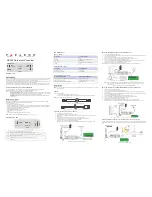
Si-95
Functions
Functions Inverter K Series
7
A. Compressor
The 20-step capacity control is achieved by the inverter scroll compressor that uses an inverter for
frequency control in a range of 30 to 116 Hz and the standard scroll compressor that uses commercial
power supply. The compressors allow individual control of indoor units and linear control.
(M1C : inverter compressor, M2C : standard compressor)
B. Oil separator
This device collects oil discharged from the compressors. The device receives oil and sends recovered oil
to the compressors through the capillary tube.
C. Solenoid valve (for hot gas bypass) Y2S
This valve maintains balance between the high and low pressure sides when the equipment stops, thus
reducing compressor load in the next startup.
This valve is activated by a low-pressure protection control function and opens when the low-pressure side
decreases in pressure.
D. Outdoor unit electronic expansion valves Y1E, Y2E
These expansion valves are activated during heating operation.
They detect the compressor suction pipe temperature and low pressure equivalent saturation temperature
and control superheat.
(Y1E : for primary-side heat exchanger, Y2E : for secondary-side heat exchanger)
E. Solenoid valve (injection) Y3S, Y4S
Controls injection solenoid valve ON-OFF in order to prevent overheating.
Y3S : for inverter side compressor
Y4S : for standard side compressor
F. Solenoid valve (discharge gas) Y5S, Y7S
Valve is opened during heating and simultaneous cooling and heating operations.
G. Solenoid valve (for pressure equalization) Y1S
This valve maintains pressure balance before and after the BS unit solenoid valve during cooling and
heating operation mode change.
H. Solenoid valve (for liquid pressure) Y6S
This valve opens a bypass to send hot gas to the receiver and controls the liquid pressure.
I. Pressure sensor (high pressure ··· red) SENPH
This semiconductor pressure sensor detects discharge pressure. The detected refrigerant pressure is
used to evaluate the operation conditions of indoor units.
Heating operation ··· The sensor detects high pressure and controls the compressor capacity.
J. Pressure sensor (low pressure ··· blue) SENPL
This semiconductor pressure sensor detects suction pressure. The detected refrigerant pressure is used
to evaluate the operation conditions of indoor units.
Cooling operation ··· The sensor detects low pressure and controls the compressor capacity.
Heating operation ··· The sensor provides superheat control.
K. 4-way valves Y1R, Y2R
(Y1R : for primary-side heat exchanger, Y2R: for secondary-side heat exchanger)
1. Outside temperature thermistor R1T
Heating operation ··· Used as a function of defrost IN condition.
The thermostat turns off when the temperature exceeds 23˚C.
2. Coil temperature thermistors R2-1T, R2-2T
(R2-1T : for primary-side heat exchanger, R2-2T : for secondary-side heat exchanger)
Cooling operation ··· Not used.
Heating operation ··· Used as a function of defrost IN condition, in combination with the outside
temperature data.
3. Discharge temperature thermistors R3-1T, R3-2T
These thermistors are used for compressor discharge temperature protection.
(R3-1T : inverter compressor, R3-2T : standard compressor)
4. Suction pipe temperature thermistors R4-1T, R4-2T
These thermistors are used for compressor discharge temperature protection.
(R4-1T : for primary-side heat exchanger, R4-2T : for secondary-side heat exchanger)
5. Oil temperature thermistor R5T
During defrost and oil return operation, provides upper-limit frequency control to improve oil diluting
condition.
SI-95.BOOK Page 7 Friday, March 31, 2000 10:59 AM
















































